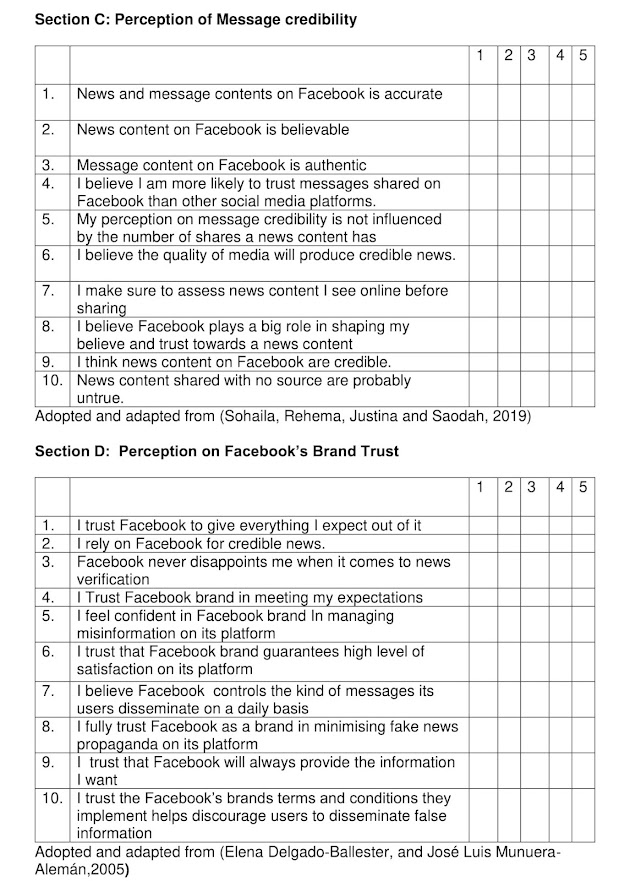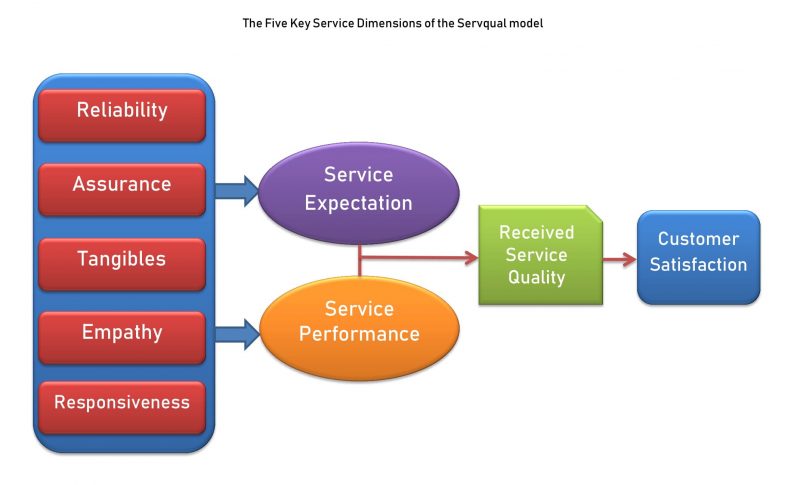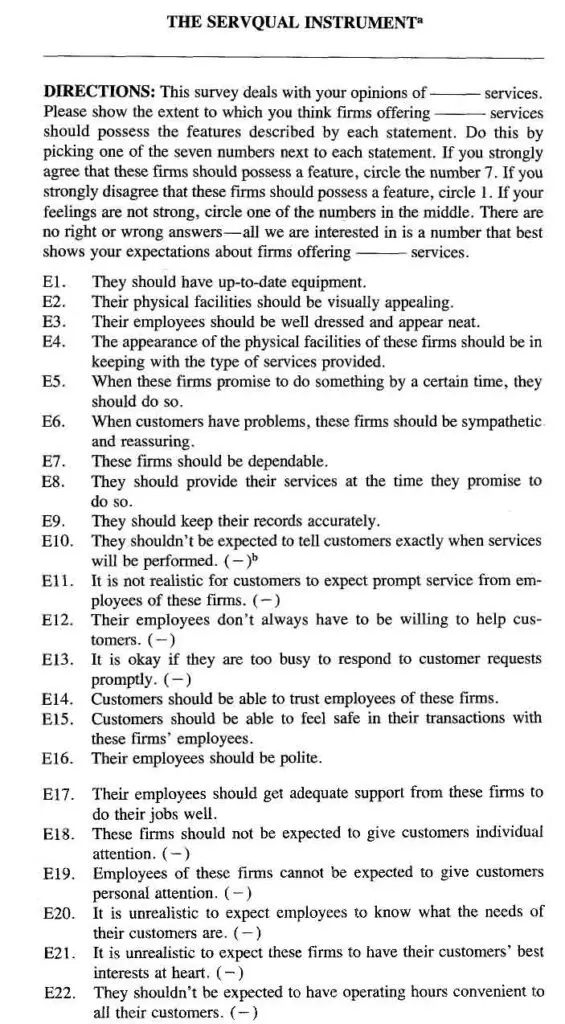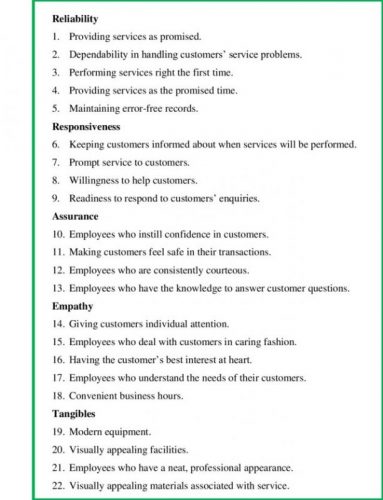Survey Questionnaire Sample For Research Paper Questionnaire Example For Research Paper Sample Questionnaire For Research Paper, Proposal, & Project PDF.
Questionnaire
A questionnaire is a quantitative survey tool consisting of multiple questions used to collect data from respondents and informants. The survey questionnaire comprises five standard 5W and 1H questions, including how, why, who, when, and what. The most common questionnaires are product usability and customer satisfaction survey questionnaires.
Additionally, questionnaires are crucial for collecting information in both quantitative and qualitative research. Quantitative survey questions consist of ‘what’, ‘why’, and ‘how’ questions to quantify something. These questions are designed to identify connections and relations among independent, dependent, mediator, and moderator variables. The respondents are a sample of the population who participate in the survey to provide information. Quantitative survey questions are part of the quantitative research’s data collection process.
In contrast, qualitative questionnaires consist of ‘what’ and ‘how’ to explore in-depth opinions about something. Qualitative research avoids why questions that are set to identify cause-and-effect relations. The survey can be conducted face-to-face or online. However, every questionnaire includes an introduction to provide a concise overview of the research.
Questionnaire Sample
A questionnaire sample is a set of survey questions used by a researcher to collect data. The author designs some questionnaire samples for students and researchers. These samples help new researchers develop a questionnaire tailored to the research topic. The questionnaire sample has been collected from University students. New researchers will learn how to create a survey questionnaire to collect data.
The author has presented several research questionnaire examples and provided download links here so readers can download the PDF form. This sample and example of research questionnaires might give a better understanding for new researchers.
Questionnaire Sample For Quantitative Research Paper
Quantitative survey research includes the title, abstract, introduction, methods, results, discussion, questionnaire, bibliography, and appendix. The questionnaire sample for the research paper will provide precise ideas about creating survey questionnaires for a quantitative research paper. Many undergraduate and postgraduate students do not know how to set up questionnaires for a thesis or dissertation. Therefore, the author has designed and collected a few samples of the questionnaire for quantitative research. We do not encourage students to copy these questionnaires; however, you can use these as inspiration to create your own questionnaire. Students should read and follow the examples to draft questionnaires for their quantitative research projects.
Sample Questionnaire for Quantitative Research-1
The following questionnaires are adopted from the UTAUT model. Therefore, this sample will help the student who wants to design a survey questionnaire based on the Unified Theory of Acceptance and Use of Technology. It includes the research title, demographic questions, and items to validate the hypothesis.
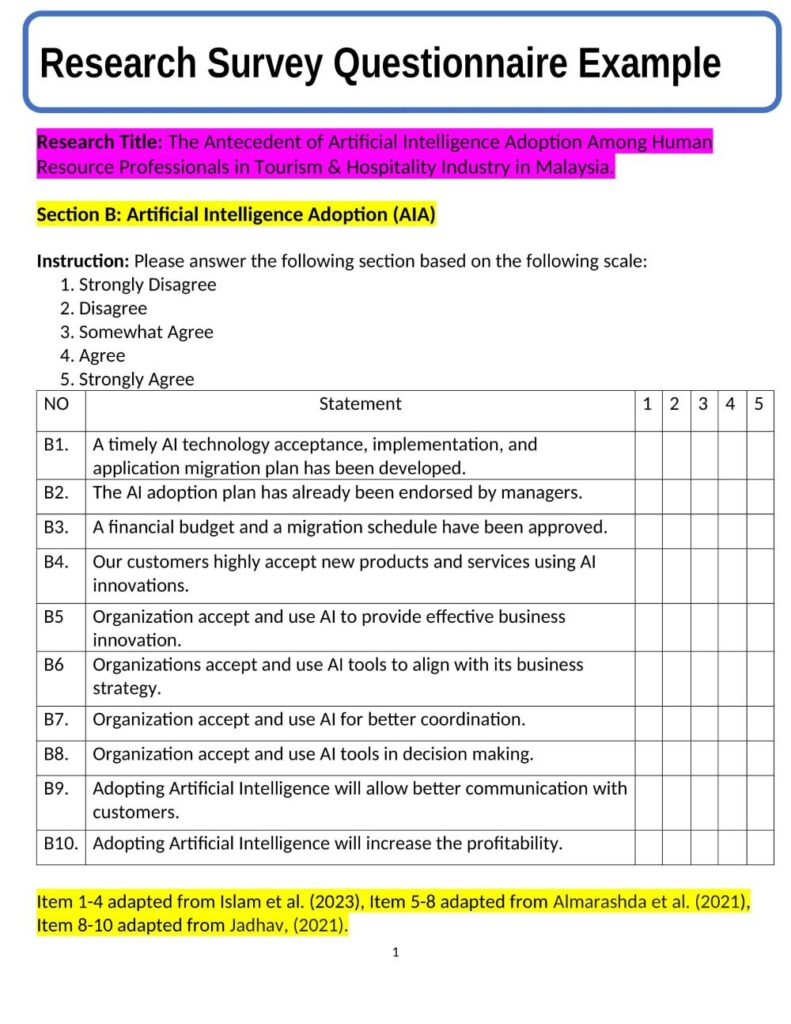
Research Title: The Antecedents of Artificial Intelligence Adoption Among Human Resource Professionals in Tourism & Hospitality Industry in Malaysia.
Online Survey Questionnaire Form
SECTION A. Demographic Questions
Instructions: Please complete this section by circling the following answers
A1. What is your gender?
- Male
- Female
A2. How old are you?
- 20-30
- 31-40
- 41-50
- 51-60
A3. What is your level of education?
- Undergraduate
- Masters/MBA
- MPhil/DBA/PhD
A6. What is your marital status?
- Single
- Married
A7. What is your job tenure?
- 1-2 Years
- 3-4 Years
- 5-6 Years
- 7 Years and above
Section B: Artificial Intelligence Adoption (AIA)
Instruction: Please answer the following section based on the following scale:
- Strongly Disagree
- Disagree
- Somewhat Agree
- Agree
- Strongly Agree
| NO | Statement | 1 | 2 | 3 | 4 | 5 |
| B1. | A timely AI technology acceptance, implementation, and application migration plan has been developed. | |||||
| B2. | Managers have already endorsed the AI adoption plan. | |||||
| B3. | A financial budget and a migration schedule have been approved. | |||||
| B4. | Our customers highly accept new products and services using AI innovations. | |||||
| B5 | Organizations are embracing and utilizing AI to drive practical business innovation. | |||||
| B6 | Organizations accept and use AI tools to align with their business strategy. | |||||
| B7. | Organizations accept and use AI for better coordination. | |||||
| B8. | Organizations accept and use AI tools in decision-making. | |||||
| B9. | Adopting Artificial Intelligence will allow better communication with customers. | |||||
| B10. | Adopting Artificial Intelligence will increase profitability. |
Item 1-4 adapted from Islam et al. (2023), Item 5-8 adapted from Almarashda et al. (2021), Item 8-10 adapted from Jadhav (2021).
Section C: Performance Expectancy (PE) and Artificial Intelligence Adoption
| NO | Statement | 1 | 2 | 3 | 4 | 5 |
| C1. | I find AI a helpful technology in the HR department. | |||||
| C2. | Using AI increases my chances of making important decisions. | |||||
| C3. | Using AI helps me make decisions more quickly. | |||||
| C4. | Using AI increases my productivity in organizations. | |||||
| C5 | AI enhances the HR department’s performance. | |||||
| C6 | AI enables us to work faster in the organization. | |||||
| C7 | AI enhances employees’ effectiveness in performing. | |||||
| C8 | Using AI technology in the HR department increases my chances of achieving things that are important to me. |
Item 1-4 adapted from Baabdullah (2024), Item 5-8 adapted from Cao et al. (2021)
Effort Expectancy (EE) and Artificial Intelligence Adoption
Instruction: Please answer the following section based on the following scale:
- Strongly Disagree
- Disagree
- Somewhat Agree
- Agree
- Strongly Agree
| No | Statement | 1 | 2 | 3 | 4 | 5 |
| D1. | Learning how to use AI technology is easy for me. | |||||
| D2. | My interaction with AI tools is clear and understandable. | |||||
| D3. | I find AI effortless to use. | |||||
| D4. | It is easy for me to become skillful at using AI. | |||||
| D5. | It is easy for me to use AI tools to manage my workload in the organization. | |||||
| D6. | Learning how to use AI tools for communication is easy for me. | |||||
| D7. | It is convenient to provide service using AI tools. | |||||
| D8 | It is easy to complete complex HR tasks. |
Item 1-4 adapted from Baabdullah (2024), Item 5-8 adapted from Venkatesh (2012).
Section E: Social Influence and AI Adoption
- Strongly Disagree
- Disagree
- Somewhat Agree
- Agree
- Strongly Agree
| No | Statement | 1 | 2 | 3 | 4 | 5 |
| E1 | People who are important to me think that I should use AI technology in the workplace |
|||||
| E2 | People who influence my behavior think that I should accept and use AI tools. | |||||
| E3 | People whose opinions I value prefer that I use AI technology | |||||
| E4 | Coworkers who are important to me would think that I should use AI. | |||||
| E5 | Peers who influence my behavior would think that I should use AI to complete the tasks. | |||||
| E6 | My superiors, who influence my behavior, would think that I should use AI. | |||||
| E7 | My superiors, to whom I report, would think that I should use AI. | |||||
| E8 | My business partners would think that I should use AI. |
Item 1-3 adapted from Venkatesh et al. (2012), Item 3-8 adapted from Cao et al. (2021)
Section F: Facilitating Condition and AI Adoption
- Strongly Disagree
- Disagree
- Somewhat Agree
- Agree
- Strongly Agree
| No | Statement | 1 | 2 | 3 | 4 | 5 |
| F1 | I have the resources necessary to use AI | |||||
| E2 | I know necessary to understand AI. | |||||
| E3 | AI is compatible with other technologies I use | |||||
| E4 | I can get help from others when I have difficulties using AI |
Item 1-4 adapted from Cao et al. (2021)
Section G: Technology competency (TC) and AI Adoption
- Strongly Disagree
- Disagree
- Somewhat Agree
- Agree
- Strongly Agree
| No | Statement | 1 | 2 | 3 | 4 | 5 |
| G1 | The technology infrastructure of our company is available to support AI tools. | |||||
| G2 | Our company is dedicated to ensuring that HR employees are familiar with AI tools. | |||||
| G3 | Our company has a high level of AI tool knowledge. |
Item 1-3 adapted from Islam et al. (2023)
Section H: Top management support (TMS) and AI Adoption
- Strongly Disagree
- Disagree
- Somewhat Agree
- Agree
- Strongly Agree
| No | Statement | 1 | 2 | 3 | 4 | 5 |
| H1 | Top managers support by providing labor resources, finances, and materials for AI adoption. | |||||
| H2 | Top management inspires employees to apply the latest AI technologies in daily work. | |||||
| H3 | The top management of my organization encourages innovation. | |||||
| H4 | My organization’s top management is willing to take the risks involved in adopting AI technologies. | |||||
| H5 | My organization’s top management is likely to consider the implementation of AI as strategically important. |
Item 1-5 adapted from Islam et al. (2023)
Section I: Competitive pressure (CP)and AI Adoption
- Strongly Disagree
- Disagree
- Somewhat Agree
- Agree
- Strongly Agree
| No | Statement | 1 | 2 | 3 | 4 | 5 |
| I1 | The company thinks that AI adoption influences competitiveness in the industry. | |||||
| I2 | The company is pressed by the competition to adopt AI. | |||||
| I3 | Some competitors have already started using AI for Risk forecasting and premium calculations. | |||||
| I4 | My organization’s top management is willing to take the risks involved in adopting AI technologies. |
Item 1-4 adapted from Islam et al. (2023)
Section J: Emotional Intelligence (EI) and AI Adoption
- Strongly Disagree
- Disagree
- Somewhat Agree
- Agree
- Strongly Agree
| No | Statement | 1 | 2 | 3 | 4 | 5 |
| J1 | Overall, I’m a highly motivated person to use AI technology in an organization. | |||||
| J2 | I feel that I have several good qualities. | |||||
| J3 | I’m usually able to influence the way other people feel. | |||||
| J4 | On the whole, I’m able to deal with stress. |
Item 1-4 adapted from Lipson, A. (2020).
Quantitative Survey Questionnaire Sample -2
An example of a complete survey questionnaire is shown below. The title of the research project is “An Examination of the Correlation Between Social Media Engagement and Citizen Journalism Practice”. It is a Google Form questionnaire sample. The author shares this online questionnaire link with respondents, and they complete it at their convenience. It is the most recent example of a questionnaire designed followed to the APA 7th edition.
Quantitative Research Title: An Examination of the Correlation Between Social Media Engagement and Citizen Journalism Practice.
Dear Participants,
I am inviting you to join this quantitative research project by completing the following survey questionnaires. This study intends to examine the Correlation Between Social Media Engagement and Citizen Journalism Practice. It requires approximately 5-7 minutes to complete the questionnaires. Thank you for taking your time to assist me with this research. Under no circumstances are you obliged to answer any of the questions; however, doing so will greatly assist me in completing my research and enhance my understanding of this research focus. The data collected will remain confidential and will be used solely for academic purposes.
SECTION A. Demographic Questions
Instructions: Please complete this section by circling the following answers
A1. What is your gender?
- Male
- Female
A2. How old are you?
- 18-23
- 24-28
- 29-33
- Above 33
A3. What is Your Nationality?
- Malaysian
- Non-Malaysian
A4. What is your race?
- Malay
- Chinese
- Indian
- Please specify
A5. What is your level of education?
- STPM
- Matric
- Diploma
- Foundation
- Undergraduate
- Masters
- PhD
A6. What is the Year of Study
- Year 1-2
- Year 3-4
- Above 5
A7. What is your family’s monthly income?
- Less thanRM2000
- RM2001 – RM4000
- RM4001 to RM6000
- Over RM6000
Section B: The Use of Social Media for Citizen Journalism
Please read the definition of social media-based citizen journalism and keep it in mind when you answer the following questions. Social media-based citizen journalism refers to generating and sharing news events (personal, social, educational, entertainment, political, and crime-related news) on social networking sites by ordinary people.
B1. What types of social networking sites do you use most to practice citizen journalism?
- Please specify…
B2. How much time do you spend on social media-based citizen journalism in a day?
- Less than 1 hour per day
- About 1 – 2 hours per day
- About 2 – 4 hours per day
- More than 5 hours per day
B3. Why do you use social media to practice citizen journalism?
- To report real-time news
- To entertain friends
- For educating people about social awareness
- To shape public opinion
- For others, please specify
B4. How many social media sites do you use to practice citizen journalism?
- Only 1 account
- 2 – 4 accounts
- 5 accounts and above
B5. What time of the day do you normally access social media?
- Morning
- Afternoon
- Evening
- At night
B6. Which day of the week do you mostly access social media?
- During weekdays
- During weekends
Section C: Performance Expectancy of social media engagement for citizen journalism
C8. What is your performance expectancy of the use of social media to practice citizen journalism?
Instruction: Please answer the following section based on the following scale:
- Strongly Disagree
- Disagree
- Somewhat Agree
- Agree
- Strongly Agree
| NO | Statement | 1 | 2 | 3 | 4 | 5 |
| C1. | I would find social media useful in practicing citizen journalism. | |||||
| C2. | Using social media enables me to share news events more quickly. | |||||
| C3. | Using social media increases my productivity in reporting real-time news. | |||||
| C4. | Social media increases my mastery of what is happening globally. | |||||
| C5 | Social media makes me aware of what news is important to my friends and co-workers. | |||||
| C6 | Using social media can increase my chances of creating and sharing informative news events. | |||||
| C7. | Using social media will allow me to spend less time reporting and consuming news. |
Items 1-3 were adapted from Venkatesh et al. (2003), Items 4-5 were adapted from Peng and Miller (2021), and Item 6-7 was adapted from Puriwat and Tripopsakul (2021).
Section D: Effort expectancy of social media engagement for citizen journalism
D9. What is your expected effort in the use of social media to practice citizen journalism?
Instruction: Please answer the following section based on the following scale:
- Strongly Disagree
- Disagree
- Somewhat Agree
- Agree
- Strongly Agree
| No | Statement | 1 | 2 | 3 | 4 | 5 |
| D1. | My citizen journalism exercise with social media would be straightforward and understandable. | |||||
| D2. | It would be effortless for me to exercise my content writing skills using social media. | |||||
| D3. | I would find social media-based citizen journalism easy to use | |||||
| D4. | Learning to operate social media to practice citizen journalism is easy for me. | |||||
| D5. | It is easy for me to become a freedom journalist using social media for news updates. | |||||
| D6. | It is easy for me to consume news on social media | |||||
| D7. | It is convenient to share the news with friends on social media | |||||
| D8 | Using social media will help me to spread the emergency news faster. |
Items 1-3 were adapted from Venkatesh et al. (2003), Items 4-7 were adapted from Peng and Miller (2021), and Item 8 was adapted from Puriwat and Tripopsakul (2021).
Section E: Social Influence of social media engagement for citizen journalism
What is your social influence of social media engagement for citizen journalism? Instruction: Please answer the following section based on the following scale:
- Strongly Disagree
- Disagree
- Somewhat Agree
- Agree
- Strongly Agree
| No | Statement | 1 | 2 | 3 | 4 | 5 |
| E1. | People who are important to me think that I should use social media for news sharing |
|||||
| E2. | The senior students of my university recommend that I use social media to search for academic news. | |||||
| E3. | People important to me talk with me about the news they saw on social media |
|||||
| E4. | I observed my friends sharing news on social media. | |||||
| E5. | I found my important friends discussing the news they read on social media. | |||||
| E6. | It makes me feel proud when my friends praise me for sharing informative news on social media. | |||||
| E7. | I become motivated when my social media friends benefit from my reporting. | |||||
| E8. | People around me consider it suitable to use social media for news consumption. |
Items 1-2 were adapted from Venkatesh et al. (2003), Items 3-5 were adapted from Peng and Miller (2021), Items 6-7 were set by the Authors, and Item 8 was adapted from Puriwat and Tripopsakul (2021).
Section F: The use of social media to practice citizen journalism
Instruction: Please answer the following section based on the following scale:
- Strongly Disagree
- Disagree
- Somewhat Agree
- Agree
- Strongly Agree
| No | Statement | 1 | 2 | 3 | 4 | 5 |
| E1. | I often use social media to share news content | |||||
| E2. | I have been using social media regularly to report real-time news with friends. | |||||
| E3. | To report real-time news to friends, I use social media regularly. | |||||
| E4. | In my daily life, I use social media to share news events. | |||||
| E5. | I take advantage of online social networking sites to perceive hard news. | |||||
| E6. | I use social networking sites to post events around me. | |||||
| E7. | Whenever I need to read viral news, I go through social media platforms. |
Item 1-5 adapted from Puriwat and Tripopsakul (2021), Item 5-7 set by the Authors
Additionally, the author has collected some survey questionnaires from students and research experts. So, these questionnaires will assist students in completing their research papers. Many students and researchers might adapt them to write the thesis and dissertation.
Questionnaire Sample For Research Paper-3
| Research Title: Malaysia’s E-commerce Websites’ Information and Its Influence on Customers’ Information Privacy Concerns.Dear Sir/Madam
The researcher is a master’s student of corporate communication at UPM. This survey aims to gain insight into Malaysia’s e-commerce websites’ information and its influence on customers’ information privacy concerns. The survey questionnaires have been adapted from previous research conducted on information privacy concerns. For a better understanding of the questions, short notes are given for more explanation on the topic. Your opinions are highly appreciated and strictly confidential. The researcher of this project has only the power to access the data. The researcher intends to include the survey report in the findings and discussion chapter. Thank You Very Much For Your Time Sample Questionnaire For Research Paper Download Link |
Sample Questionnaire For Research Paper-4
| Research Title: Communicating Copyright Law in Malaysia: The Perception of Undergraduate Students in University Putra Malaysia.
Dear Participants. Sincerely, Name: Final Year Student from the Bachelor of Communication program Sample Questionnaire For Research Paper PDF |
Questionnaire Sample For Research Paper-5
| Research Title: From a Pandemic to an Infodemic: Establishing a Health Information Overload Model Based on the COVID-19 Outbreak in Malaysia.
Dear respondent, I hope you are doing well and staying safe. We are a health communication research team from the Department of Communication, Faculty of Modern Languages and Communication (FBMK), Universiti Putra Malaysia (UPM). We are conducting a research project to understand how Malaysians perceive COVID-19 as dangerous and serious, what social media they use to seek information, and how likely they are to be overloaded with it. Meanwhile, we also seek to understand how much Malaysians understand the virus and intend to get the COVID-19 vaccination. There are eight (8) sections in this online survey questionnaire. You are expected to answer ALL the questions listed. Your participation in this study is completely voluntary. You do not have to be in this study if you do not want to. If you volunteer to be in this study, you may withdraw from it at any time. There is no potential risk or harm to you for participating in this research project. If you have any concerns or questions, please contact the investigators of this research project. You are also very encouraged to share this questionnaire with your family members, friends, and others in your community; it would surely help us better understand COVID-19 issues in Malaysia. Please click the “NEXT” button below to answer the questions if you agree to participate in this research. Thank you for your time, and we hope you and your loved ones are staying safe always. Sample Questionnaire For Research Paper Download Link |
Survey Questionnaire Sample For Research Paper-6
|
Project Title: Factors Affecting the Adoption of E-Payment Among Bangladeshi Students in Bangladesh Dear respondents, I am a final year undergraduate student in the Bachelor of Business Administration (BBA) from the University Putra Malaysia (UPM). This survey aims to evaluate the factors affecting the adoption of e-payment among Bangladeshi Students in Bangladesh. Instruction: There are SIX (6) pages in this questionnaire. Please answer ALL questions that are needed on ALL pages. Completion of this questionnaire will take you approximately 5 to 10 minutes. Please feel free to share your information in the space provided. The content of this questionnaire will be kept strictly confidential and used only for academic research papers. Thank you very much for your time. Sample Questionnaire For Research Paper PDF Download |
Questionnaire Sample For Students PDF-7
|
Project Title: The Effectiveness of Communication Efforts on Mount Fuji, Japan.
Hello respondents! We are students from University Putra Malaysia’s KOM3405 (Heritage Communication). We are currently surveying the effectiveness of communication efforts on Mount Fuji, Japan. So, we would like to invite you to participate in this survey. Mount Fuji is the highest mountain in Japan. It is one of the World Heritage Sites as stated by UNESCO (United Nations Educational, Scientific, and Cultural Organization). The information provided is only for academic purposes and will be strictly confidential. This participation is entirely voluntary. This survey will only take 5 minutes. Your participation is highly appreciated. Thank you. Sincerely, |
Survey Questionnaire Sample For Research Paper-8
(Sample demographic questionnaire for students)
 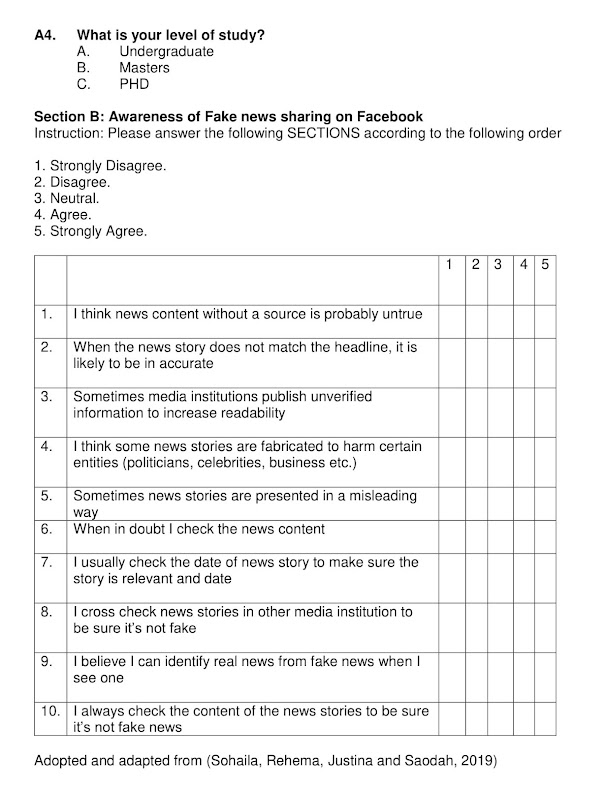
|
Survey Questionnaire Sample For Thesis Paper-9

Dear respondent,
I am a student at the Department of Communication, Faculty of Modern Languages and Communication at the University of Putra Malaysia. I wish to collect some information about your awareness of obesity.
You are invited to participate in this survey, in which your insight and information are valuable for us to strategize the health communication campaign to be more effective. I greatly appreciate your help in providing us with your honest answers to the questions below. I reassure you that the information gathered in this paper will only be used for event purposes and kept confidential.
Thank you.
SECTION A: DEMOGRAPHIC
| A1 | Ethnic | Malay | Indian | ||
| A2 | Gender | Chinese. | Other: ______________ | ||
| □ Male. | □ Female | ||||
| A3 | Age | □ | Below 15 | □ | 31–35 |
| □ | 15–19 | □ | 36–40 | ||
| □ | 20–25 | □ | 41–45 | ||
| □ | 26–30 | □ | Above 45 | ||
A4. Which written language(s) do you understand? (Choose whichever is relevant.)
| □ | Malay | □ | English |
| □ | Chinese | □ | Tamil |
A5. Which spoken language do you prefer? (Choose one (1) ONLY)
| □ | Malay | □ | English |
| □ | Mandarin | □ | Tamil |
| □ | Cantonese | □ | Hakka |
| □ | Hokkien | □ | Other: ___________ |
SECTION B: MEDIA CONSUMPTION
B1. What are the primary sources you use the most to obtain health information? (Choose a minimum of one (1) answer and a maximum of three (3) answers).
| □ | Newspaper | □ | Internet |
| □ | Magazine | □ | |
| □ | Television | □ | |
| □ | Radio | □ | |
| □ | □ | Other: ______________ |
B2. If you have selected a newspaper as one of the sources for obtaining health information, which newspaper vehicle do you read the most? (Choose one (1) ONLY)
| □ | Sin Chew Daily | □ | Guang Hwa Daily |
| □ | China Press | □ | Daily News |
| □ | Nanyang Siang Pau | □ | The Star |
| □ | Utusan Malaysia | □ | Berita Harian |
| □ | Kosma! | □ | News StraitTime |
| □ | Guang Ming Daily | □ | Other: ______________ |
SECTION C: MEDIA PREFERENCE
C1. Do you watch local television (TV) station(s)?
- Yes (Proceed to Q2)
- No (Proceed to Q4)
C2. How many hours of TV do you watch in a day? (Choose one (1) ONLY)
- Less than 1 hour per day
- 4-6 hours per day
- 1-3 hours per day
- More than 6 hours per day
C3. Which TV channel do you watch the most? (Choose one (1) ONLY)
| □ | Astro | □ | NTV 7 |
| □ | RTM 1 | □ | 8TV |
| □ | RTM 2 | □ | TV 9 |
| □ | TV 3 | □ | Other: ______________ |
C4. Do you listen to the local radio?
- Yes (Proceed to Q5)
- No (Proceed to Q7)
C5. How many hours of local radio stations do you listen to a day? (Choose one (1) ONLY)
- Less than 1 hour per day
- 1-3 hours per day
- 4-6 hours per day
- More than 6 hours per day
C6. Which local radio station do you listen to the most? (Choose one (1) ONLY)
| □ | One FM | □ | Hitz. FM |
| □ | 988 FM | □ | Fly FM |
| □ | Melody FM | □ | Lite FM |
| □ | MY FM | □ | Mix FM |
| □ | Ai FM | □ | Era FM |
| □ | Red FM | □ | Hot FM |
| □ | Sinar FM | □ | Other: ______________ |
C7. Which social media do you use the most? (Choose one (1) ONLY)
| □ | □ | ||
| □ | □ | ||
| □ | □ | Other: ______________ |
SECTION D: Awareness of Obesity
Tick (✓) the spaces provided to indicate your level of agreement with the statements below.
Instruction: Please answer the following section based on the following scale:
- Strongly Disagree
- Disagree
- Somewhat Agree
- Agree
- Strongly Agree
D-I. Problem Recognition
| No | Statements | 1 | 2 | 3 | 4 | 5 |
| 1 | Obesity is becoming an increasingly significant problem in my community. | |||||
| 2 | There is an urgent need to solve the obesity problem in my community. | |||||
| 3 | There is much room for local authorities and the government to improve the policies controlling obesity in Malaysia. | |||||
| 4 | I believe the prevention of obesity is essential. |
D-II. Constraint Recognition
| No | Statements | 1 | 2 | 3 | 4 | 5 |
| 1 | I cannot do anything to solve the obesity problem in my community. | |||||
| 2 | My efforts to combat the obesity problem in my community are pointless. | |||||
| 3 | I do not see any point in trying to encourage my community members to control their weight. | |||||
| 4 | I think I could not affect my community members to control their weight and prevent obesity. |
D-III. Involvement Recognition
| No | Statements | 1 | 2 | 3 | 4 | 5 |
| 1 | I am concerned that gaining weight is affecting my life. | |||||
| 2 | I believe obesity could affect my health. | |||||
| 3 | I have a strong opinion about obesity. | |||||
| 4 | I feel that obesity affects me personally. |
– – End of Survey Questionnaire – –
Thank you for answering.
Conclusion
This article titled “Survey Questionnaire Sample For Research Paper” helps students to complete their master’s and PhD thesis and research projects. Every quantitative survey research paper includes a questionnaire to collect data.
